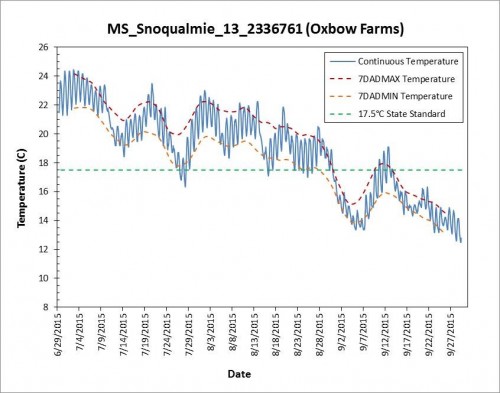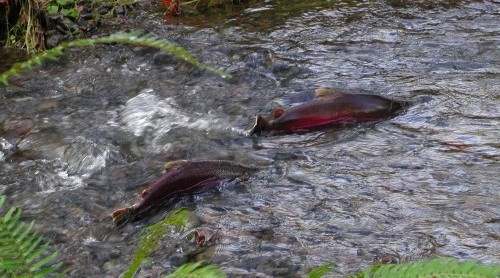The salmon story continues
Many a time this season we have made note of how devastating a year this one has been for salmon. In August, we published a story describing a study that is monitoring water temperature in the Snoqualmie River and its tributaries. This study, being conducted by the Snoqualmie Watershed forum with support from King County, aims to help ecologists understand how this year’s drought conditions have affected the habitat and survival of our local salmon. Janne Kaje, the study team’s lead, and colleagues have since shared more data and updated us on how things are looking this fall.
Early data from July indicated troubling conditions. Water temperatures in the Snoqualmie River bordering Oxbow were substantially higher than past norms and much too high for salmon to live comfortably–warm temperatures stress their immune systems, increase their metabolisms, and make it harder for them to breathe. After months of drought-like conditions and staring down consistent forecasts in the 90s, the situation seemed grim.
Two months later, what’s going on? Did the late summer’s few rains and calmed-down temperatures rescue the salmon from the summer’s dangerous conditions?
The outlook, at least for now, is unsure. River temperatures have descended back into an acceptable range for salmon, but populations are likely still reeling from abnormally high spring and summer temperatures. As of mid-August, the 7-day maximum temperature at Oxbow remained between 21 and 23 degrees Celsius, a good three to five degrees warmer than wildlife biologists at Washington Department of Fish and Wildlife recommend.

Data from a thermistor in the Snoqualmie River at Oxbow Farm. The blue line represents continuous temperature readings. The red and yellow lines represent the average maximum and minimum temperatures recorded over seven days. The green dotted line is the state standard 17.5 degrees Celsius,, above which salmon struggle to survive.
Temperatures dropped significantly as August turned into September, the result of an August 29th rainstorm that dumped an inch of water across the Snoqualmie Valley. After a short warming in early September, temperatures have continued to drop and are now steadily reading within a comfortable range for salmon. But a lot of damage has probably already been done.
We say probably because it’s simply hard to know. Different species of salmon spawn in different places at different times, so it’s tough to draw conclusions about the season’s overall effects on the entire population before the spawns end in late fall. According to Janne, the number of sockeye salmon returning to spawn in the Columbia River and locally in the Cedar River (and counted at the Ballard Locks) in July were alarmingly low–the water was even warmer then than in August. But sockeye spawn earlier than most other species, and generally don’t venture into the Snoqualmie Basin. Pink salmon, coho, and chinook spawning runs are underway. Washington Department of Fish and Wildlife and the Tulalip Tribes count returning spawners each year and the Tulalip also count out-migrating juvenile fish in the spring, so we should know soon how this year’s numbers compare to those of previous seasons.

Coho salmon returning to spawn in the Tillamook National Forest. Photo credit Oregon Department of Forestry
Although the temperature evidence suggests bad news, the Snoqualmie is such a large river system that fish are actually difficult to observe and count. At this point, much of the thinking is speculative. Temperature is one factor affecting salmon’s spawning capabilities, but another big one is river flow. Salmon–especially coho–struggle to find suitable spawning grounds when water levels are too low for them to access some tributaries. Furthermore, as the summer’s high temperatures may have killed many juvenile salmon, Janne explains that we could see a lingering effect in years to come when there are fewer adults returning to the river to spawn.
We will be sure to share information about how things have progressed through the fall as we receive it. This winter, the Snoqualmie Watershed Forum/King County study team will have the data they need to evaluate the season in its entirety. We are excited to learn from them and share that information.
Salmon spawning is in full swing around the Puget Sound and will continue through the fall. King County has organized opportunities to cheer salmon on in several watersheds through their Salmon SEEson program. You can see a list of those dates and locations, as well as volunteer opportunities, on the program’s website.
This story appeared in our newsletter October 12. Sign up to receive it.
Want more Ox? Follow us on Facebook, Twitter, or Instagram or subscribe to our newsletter.
